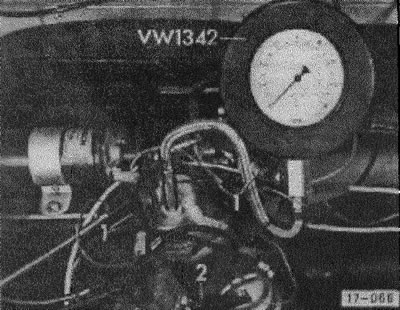Only cars produced up to 7.85 g.
The oil pressure switch is located in the oil sump and, together with a control lamp on the dashboard, serves to control the oil pressure. The membrane switch makes or breaks the connection of the warning lamp to ground.
With the engine turned off - there is no oil pressure - the control lamp is connected to ground. Therefore, when the ignition is switched on, the control lamp lights up, as there is no oil pressure.
After starting, under normal conditions, pressure builds up immediately. The membrane in the switch moves the contact plate inside the switch, the pilot lamp goes out and thus signals that there is sufficient pressure. If the lamp lights up briefly on sharp turns, this is usually a sign of a low oil level.
Disconnect the electrical wire from the oil switch, unscrew the switch.
When installing, screw in the switch with a tightening torque of 30 Nm.
Examination
Remove the oil switch and screw the switch into a suitable control device.
Screw the control device into the oil cooler instead of the oil switch.

Connect wire -1- (blue) control device with oil switch with oil switch wire, wire -2- (brown) connect with mass.
Turn on the ignition. The oil pressure warning light should come on (provided that the lamp itself and the wiring are in order). Otherwise, replace the switch.
Start the engine, slowly increase the speed and thus the oil pressure. At an overpressure of 0.15-0.45 bar, the lamp should go out.
Continue to increase engine speed. At 2000 rpm and an oil temperature of +80°C, the oil pressure must be at least 2.0 bar (atm.).
If this pressure is not reached at this speed, this is a sign of worn crankshaft bearings.

Visitor comments